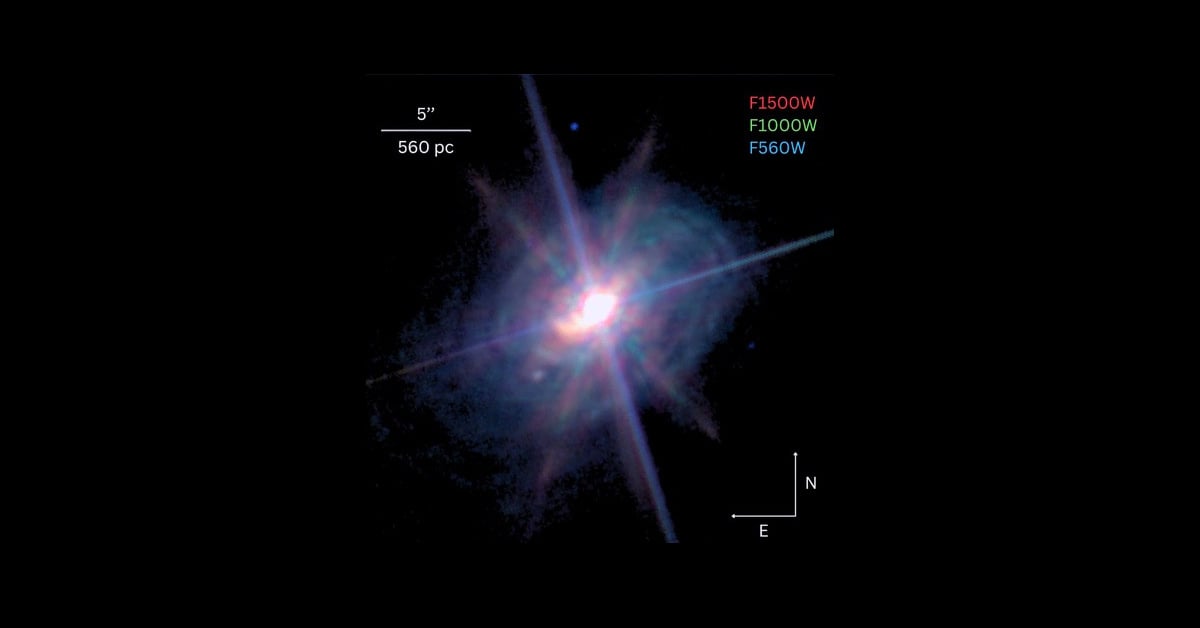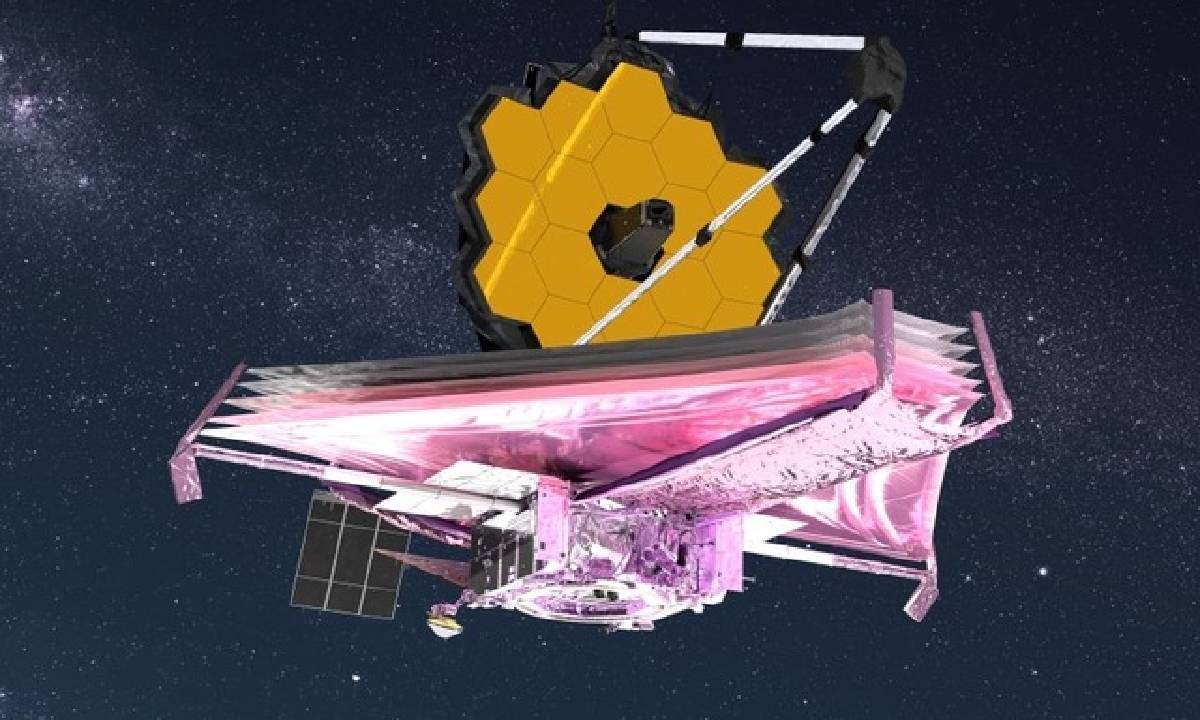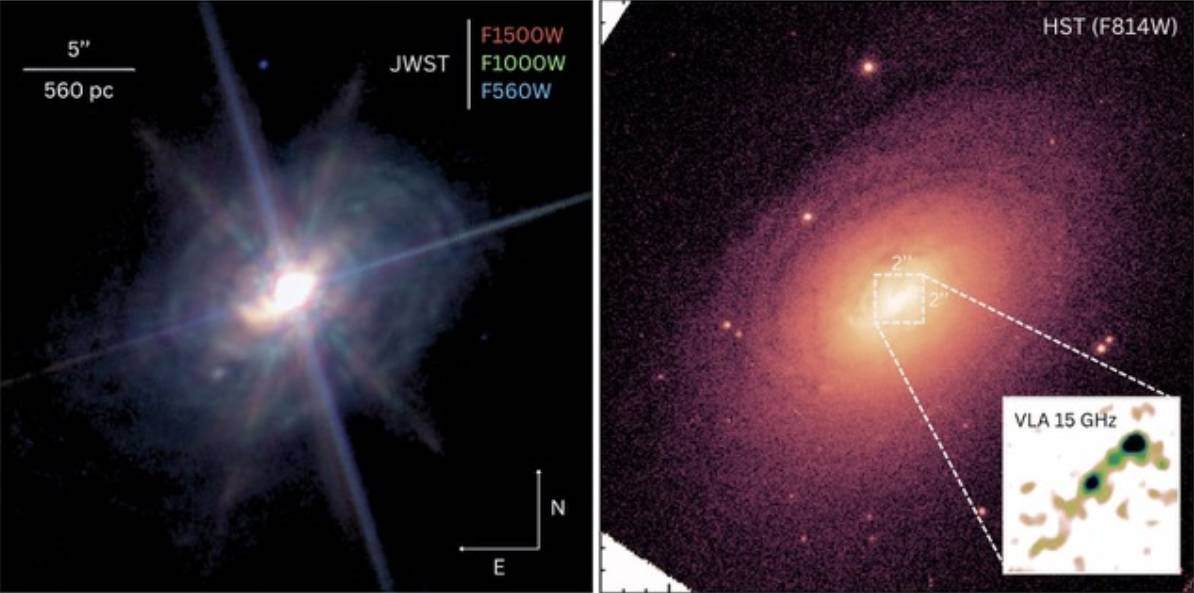James Webb Space Telescope shines light on a mysteriously dusty supermassive black hole
5 September 2024 | By: Newcastle University | 3 min read
The James Webb Space Telescope (JWST) has found a hidden veil of dust near a supermassive black hole.
Find out how a team of international scientists, led by researchers at Newcastle University, have examined this structure of dust and what it means for our understanding of supermassive black holes.
Contents:
- Pioneering observations
- What are supermassive black holes?
- Supermassive contradictions
- 70 million light-years away
- JWST reveals the AGN’s hidden core
- Astrophysical jets and dust
- What does this mean for our understanding of supermassive black holes?
Pioneering observations
The team at Newcastle University has been working with some of the first dedicated JWST observations ever taken.
Led by Houda Haidar, PhD student in the School of Mathematics, Statistics and Physics, and members of the Galactic Activity, Torus, and Outflow Survey (GATOS), this international collaboration has been studying the centres of nearby galaxies using JWST.
GATOS aims to crack the galactic enigmas that are growing supermassive black holes.
GATOS studies the cooler material in the very central regions of galaxies to understand dynamic gas flows, obscuration by dust, and the mysterious torus – the doughnut-shaped cloud of gas that ultimately feeds the supermassive black hole.

GATOS is the research group currently investigating dynamic gas flow cycles, polar dust emissions, the torus, and obscuring materials.
What are supermassive black holes?
Black holes have such a phenomenal pull that even light cannot escape the hole's grasp.
Supermassive black holes are the largest type of black holes - having a mass more than 1 million times that of our sun, according to NASA. Evidence suggests that in every large galaxy you can find a supermassive black hole at its centre.
Supermassive contradictions
As we know, black holes do not emit light themselves.
However, their immense gravity heats up the gas around them as it falls into the hole. When a supermassive black hole is actively feeding on the surrounding matter, it can release a tremendous amount of energy that can sometimes be brighter than all stars combined in the galaxy. The resultant light and radiation, captured by our telescopes, gives astronomers the means to understand these mysterious areas of spacetime.
This illuminating phenomenon is referred to as an “Active Galactic Nucleus” (AGN), and is thought to be central to shaping how the host galaxy evolves over cosmic time.
‘’What I find truly fascinating about supermassive black holes’’ said Houda Haidar, “is that despite being black and invisible, they can transform into some of the brightest objects in the Universe when active.’’
In many AGN, the thick clouds of dust and gas that feed the nucleus can also block its view from observers on Earth, making it difficult to directly observe the core and understand the processes at play.
70 million light-years away
The galactic home of the supermassive black hole studied by GATOS is ESO 428-G14, a galaxy 70 million light years away. Its AGN has been the target of many observations over the past few decades, but this is the first time JWST has turned its eyes on this galaxy.
"Having the opportunity to work with exclusive JWST data and access these stunning images before anyone else is beyond thrilling,” said Houda. “I feel incredibly lucky to be part of the GATOS team. Working closely with leading experts in the field is truly a privilege.''
JWST reveals the AGN’s hidden core
The JWST can peer into the deeply hidden places of the cosmos. Its infrared vision picks up information on the clouds around an AGN and allows scientists to look through them to its hidden core, it’s “heart”.

Image of the James Webb Space Telescope. Illustration: NASA GSFC Cil Adriana Manrique Gutierrez
At the same time, the telescope's sharp eye allows us for the first time to resolve the detailed structure of this dust across hundreds of light years. Thanks to this, the research team were able to uncover the dusty veil that was blocking our view of the supermassive black hole nesting in the heart of ESO 428-G14.

Comparison between the JWST image (left) and the HST image (right). The zoomed-in region highlights the radio emission from the jet. Photo: Adapted from Haidar et al., MNRAS, 2024, based on data from NASA/ESA/CSA/JWST
Astrophysical jets and dust
The new JWST images of ESO 428-G14 reveal that much of the dust near the supermassive black hole is spread out along the radio jet. A radio jet is a phenomenon whereby an AGN has created powerful streams of radiation and particles travelling at the speed of light.
Unexpectedly, the research found a close relationship between the dust and the radio jet, suggesting that the jet itself may be responsible for heating and shaping the observed dust.
This research implies that the energy that heats the dust comes from collisions of gas moving at very high speeds (shocks), rather than by radiation from the supermassive black hole in the galaxy.
Dr David Rosario, Senior Lecturer at Newcastle University, and co-author of the study, said: “There is a lot of debate as to how AGN transfer energy into their surroundings. We did not expect to see radio jets do this sort of damage. And yet here it is!''
What does this mean for our understanding of supermassive black holes?
We’ve been given new insights into our universe.
By studying dust close to supermassive black holes, we are learning how galaxies recycle their material, this helps us understand the processes by which supermassive black holes influence galaxies, including our own.
You might also like
- to read the research paper: Haidar, H. et al. (2024), ‘Dust beyond the torus: Revealing the mid-infrared heart of local Seyfert ESO 428-G14 with jwst/miri’, Monthly Notices of the Royal Astronomical Society, 532(4), pp. 4645–4660. doi:10.1093/mnras/stae1596
- to find out more about our School of Mathematics, Statistics and Physics
- to read our press release about this research
- to discover more about the GATOS collaboration: https://gatos.myportfolio.com
